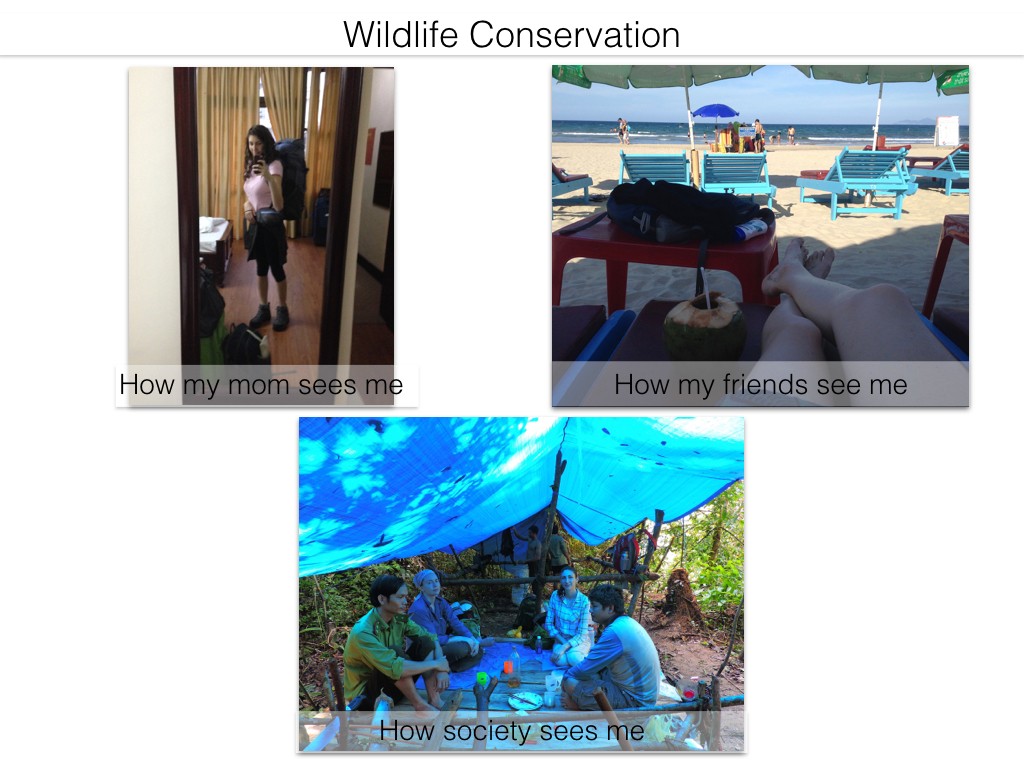One of the questions I get asked most frequently since I finished my internship in Vietnam has been: “What did you really do there?”
At first I couldn’t interpret the skepticism and a little disappointment I read on the faces of relatives and friends. “What do you mean, you didn’t spend your days cuddling those little endangered monkeys?” they said.
Today we all know that the loss of biodiversity and the disappearance of endangered species has been caused by human activities. Human patterns of consumption and behavior that, more often than not, get around laws enacted to protect the environment, continue to produce profound and irreversible damage to our planet. And this happens in shapes and sizes sometimes so widespread and deeply rooted as to suggest organized crime.
No, I have to say it hasn’t been easy to explain to those who asked that my role was not that of a knight in shining armor intent on fighting wildlife crime in Southeast Asia.
Or perhaps I did! Because if it is true that anyone fights when and how they can against daily injustices, I tried to engage my personal battle against illegal trade with the weapons of social science.
This post is a sequel to two previous ones in which I described my experience in the forests of Vietnam with the team at the Center for Biodiversity and Conservation at the American Museum of Natural History (AMNH), and their project to study the elusive slow loris.

Here I hope to answer the question posed to me by those who have wondered what I was doing in the forest, and how the creation of an econometric model and the use of social sciences could help respond a problem that has typically occupied only biologists.
Scientific knowledge and beyond
The ecology of endangered species is the foundation of “conservation biology.” Biological and ecological knowledge is therefore important but not sufficient to tackle the problem in all of its complexity. The science that deals with the conservation of biodiversity must try to expand beyond biology to examine the root causes of biodiversity loss. It is becoming vital to understand all the social factors such as markets, cultural beliefs, social values, laws and policies that form human interactions with the environment.
Therefore, we need an interdisciplinary approach to formulate hypotheses for solutions that ensure the sustainable conservation of biodiversity, especially in areas where wildlife trafficking is widely practiced.
Social problems
As is well known, the wildlife trade is particularly widespread and constitutes a serious problem in South East Asia, where increasing wealth and the consequent increase in demand for natural products coincides with poor and ineffective enforcement of existing laws. Unfortunately, in this region there still remains a lack of understanding of the socioeconomic factors underlying the trade in wildlife, how they interact at different scales, and the way in which these phenomena are related to the potential effectiveness of different policy interventions put in place by local governments.
The hypotheses
The Center for Biodiversity and Conservation project in which I participated is working to verify the following assumptions:
- Vietnam today is considered to be an important crossroad and a transit market for the illegal trade in wildlife in Southeast Asia;
- The presence of a high regional and international demand is among the main factors driving the illegal activities of the wildlife trade, as well as the specific individuals in the supply chain.
The target animal
Led by my supervisor, Dr. Mary Blair, the project focuses on a particular group of wild species for which illegal trade currently represents the biggest threat: the slow loris. The slow loris was chosen because it is a favorite subject of local, regional and international demand and may well illustrate the role of Vietnam as a transit market as well as a supply source.
Ongoing project
The proposed project is ongoing and is progressing in an interdisciplinary way by carrying out an econometric analysis on data sets that combine biological information and socioeconomic information on the individuals involved in the trade of the slow loris at different scales.
Further analysis is also being developed around the legislative and regulatory structure that combats illegal trafficking in this region. This research, the subject of my thesis, is necessary to verify the effectiveness of national policies to combat the wildlife trade, and it should provide a basis for further bio-economic models.
This project will be one of the first studies aimed at integrating socioeconomic and biological analyses to understand the key drivers of the illegal trade in wildlife. Our econometric models will also be among the first to examine this region of the world where wealth per capita and urban consumption of wild meat and forest resources are among the dominant components of domestic trade.
This work is crucial to bridge the biggest information gaps about the business and uses of wildlife in Southeast Asia, potentially providing a basis on which local and national governments could develop a series of legislative actions to coordinate more valid incentives and to promote deterrents toward different aspects of this illegal trade chain.
How do you see me now?
After reading my blog posts, I hope my mom doesn’t see me as the inexperienced explorer who is afraid of leeches; I hope my friends realize I didn’t spend every afternoon at the beach. I hope society doesn’t see me as a refugee, camping in the forest and eating insects, but maybe it still does.
I am not saying that none of that happened, but everybody saw part of the truth of what my experience was like and my hope is that I have been able to communicate the reasoning behind the research, and most importantly my personal growth beyond the intellectual accomplishments.

